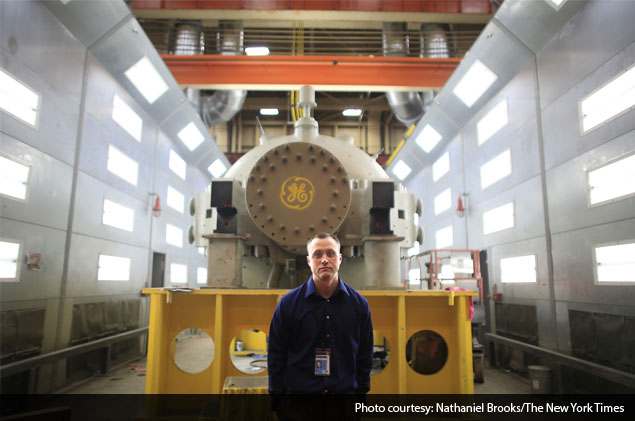- Home
- Internet
- Internet News
- GE makes the machine, and then listens to it
GE makes the machine, and then listens to it

And here, Eric Anderson wants to invent the tomorrow after that - a future of endless digital information and the means to make sense of it.
In other words, a future of Big Data.
More than a century after Edison moved his Edison Machine Works to Schenectady, laying the groundwork for what would become the General Electric Co., Anderson is deploying myriad sensors to collect information about what happens inside a massive steam-driven GE generator: heat, vibrations, pressure and so on. Working at peak, the contraption can light 750,000 homes.
"We're designing these for the next 30 years," Anderson, a senior engineer at GE, said of the company's steam-driven generators. "We'll want to know everything that's going on, so we can start to make predictions about what else will happen."
The sensors inside the turbine will feed data into an even larger computer system, channeling information about things like fuel costs, weather, demand for power in this town or that, and alternative supplies of electricity. All of that data will be churned by computer algorithms to find the optimal performance for the conditions of the moment. Should the turbine run harder, given forecasts of a heat wave? Can wind turbines pick up the load for a day or two? What are the maintenance costs? How well trained is the new worker on the crew?
"The process of making power doesn't change," Anderson said. "It is still thermal energy, to mechanical energy, to electrical energy. But now it's about instrumentation, data and prediction, too. That's all different."
In much the way clicks on an Internet browser tell Google what search results and ads to show next, voluminous data enables faster insights, and faster feedback loops, in fields that include manufacturing, national security, health care and agriculture.
And much the way the Internet has raised new issues around freedom and privacy, the wealth of new information seems likely to afford unprecedented new control over the behavior of things and people. Across the global economy, computer scientists, hospital technicians, consumer marketers, bankers, soldiers, students and more see new possibilities.
"One thing we can say for sure is that many domains will gain a lot by recording and collecting everything, then putting computing people on top of it all," said Jon M. Kleinberg, a professor of computer science at Cornell University. "It will change the way we think about ourselves, other people and society."
Data seemingly collected for one purpose can be easily used for another, Kleinberg worries. "You study a power grid to learn about turbines, but you also learn things like people's bedtimes, and how they commute," he said. "The part that is less clear is always the harms that happen."
The trend may change venerable companies like GE in striking ways. A thousand feet from the cavernous Building 273, where Anderson builds turbines with 1,100 hourly workers, many of 20,000 sensor-rich wind turbines built by GE are managed by a handful of people, replacing scores of local employees.
Service contracts like these have been important to GE for decades, but the company thinks that automated, data-infused management will be far more profitable. Problems can be caught earlier, and there will be much more knowledge about how things behave in the real world, interacting with other people and things.
Each wind tower feeds data into the system 400 times a second. In turn, its blades are adjusted for demand from the grid, what the other towers on the wind farm are doing and the power supply coming from conventional turbines. Two years from now, the turbines will feature lasers that sense the wind 100 meters out, adjusting their blades for the next gust. In the last year, GE became the world's top seller of wind turbines thanks to the data technology.
Because wind is fickle, the energy goes to batteries that feed power to the grid when the data says to. Those batteries are made with a new kind of nickel-salt composite, in full commercial use for less than a year, that is created next door to the wind center. The factory has just 250 hourly workers and 10,000 sensors, reading information four times a second. Each cell in every battery has its own history of the people, chemicals and processes contributing to its creation.
Six months ago, the $170 million factory had a reject rate from poorly made products of 22 percent, among the world's lowest for this kind of technology. Normally it takes years to get that yield from a new material. Using Big Data, the company has also expanded the diameter of its wind turbines by 23 percent using cheaper materials, testing the machines under 300 different situations.
Those results have GE rethinking 30 years of offshoring and outsourcing its manufacturing to cheaper suppliers in far-off countries. There is now data lust for every product, as each mass-produced object is also seen as something unique in its creation and use. More than 250,000 GE turbines, locomotives, jet engines and medical devices are in operation around the world, and controlling all that data improves the profitability of its service contracts and its future manufacturing.
"Now we want to look at the life of every specific machine, all the parts of manufacturing, how everything behaves," said Mark M. Little, GE's chief technology officer. "I've spent a career trying to offload manufacturing. Now we're talking about vertically integrating again."
Little started in steam generators 35 years ago and now runs a center with 2,000 Ph.D.'s and advanced software engineers, about twice the number of Building 273's manual laborers. At its height, GE Schenectady employed 45,000 people; 4,000 now work there. The company has over $100 billion in revenue from heavy industry, but the big push is into software that can better analyze and manipulate that world.
That push began about two years ago, when Little and Jeffrey R. Immelt, GE's chief executive, began to take note of the kind of efficiencies that companies like Google, Amazon, Yahoo and Facebook were able to realize on the Internet, using lots of data to overtake traditional competitors in publishing and media.
Much sensor data, like much of the information on the Internet, is unstructured data, which means it does not easily fit into the kind of database grids on which most businesses have relied. To figure out efficiently what is on numerous Web pages in order to catalog things for Internet search or mechanically snoop on the content of emails to put the right ads next to them, these companies came up with new methods of dealing with all kinds of data, in fast feedback loops.
Sensors and data storage had become cheap and abundant, filling GE's computers with lots of data it had not kept before. Immelt committed $1 billion toward seeing whether GE could use those Internet skills in its business.
Two floors below Little's office, those skills are being applied to, of all things, the venerable locomotive. Using global positioning data, as well as sensors across tracks, in the engine and on cars, software can figure out the horsepower needed to run everything at just the right speed, using the mass of a train, the local topography, even the temperature inside tunnels. Other trains on tracks and in yards pour out similar amounts of data.
There are tens of millions of variables every second. At such a large scale, even small changes matter. Running a national rail network one mile per hour better is worth $200 million a year. Improving the wait times in rail yards by 15 percent saves $500 million.
Near Cincinnati, where GE makes jet engines, complex calculations about the weight and makeup of materials are used in 3-D printers that make certain aircraft parts.
To help figure out airport delays, the company hired statisticians from Kaggle, which runs contests to find the best data scientists worldwide. They looked at 35 factors with hundreds of variables each, like weather, cloud cover, gate availability and regional traffic. The results cut average delays in landing to four minutes, from seven.
"People talk about Facebook being complex," Little said. "This is geometrically more complicated. But even a 1 percent difference in the industries we're in is huge."
GE might also want to look at its own internal operations. All of that offshoring and diversification have given the company more than 450 different and incompatible complex planning systems, the kind of software complexity that even Big Data cannot yet manage. So far, there are no plans to overhaul the complexity of that world.
Instead, GE has opened an in San Ramon, Calif., not far from Silicon Valley. Impatient with how much data it is already collecting, GE is working with Internet companies on new ways to run bigger power systems, how to manage hospital beds in a way that keeps nurses happy or figuring out which trees to cut before a storm hits and knocks out power lines.
"What will all of this look like when 50 billion machines around the world get connected?" said William Ruh, the head of the San Ramon operation. "It will certainly change the way we operate machines and how we operate the company, and it will change lots more besides."
People will invent new kinds of analysis, he says, in a world of "data fusion" that combines advanced math and supercomputing in entirely new ways.
That, he says, may be the least of the ways data analysis will change us. "My kids are already comfortable with technology that makes decisions for them, like what route to drive," he said. "To the next generation, these will be the tools of insight.
"There will be changes in human behavior. People who are used to working from gut experience will ignore data that doesn't agree with their preconceptions and will miss the productivity gains."
People will also learn to manage themselves more closely, he said: "Everything you say will be saved and annotated. Will that make us all supercareful, or will we grow immune to things people say? Who owns that record at work, and what will they use it for? We don't know, but that is where the world is taking us."
© 2013, The New York Times News Service
Get your daily dose of tech news, reviews, and insights, in under 80 characters on Gadgets 360 Turbo. Connect with fellow tech lovers on our Forum. Follow us on X, Facebook, WhatsApp, Threads and Google News for instant updates. Catch all the action on our YouTube channel.
Related Stories
- Samsung Galaxy Unpacked 2025
- ChatGPT
- Redmi Note 14 Pro+
- iPhone 16
- Apple Vision Pro
- Oneplus 12
- OnePlus Nord CE 3 Lite 5G
- iPhone 13
- Xiaomi 14 Pro
- Oppo Find N3
- Tecno Spark Go (2023)
- Realme V30
- Best Phones Under 25000
- Samsung Galaxy S24 Series
- Cryptocurrency
- iQoo 12
- Samsung Galaxy S24 Ultra
- Giottus
- Samsung Galaxy Z Flip 5
- Apple 'Scary Fast'
- Housefull 5
- GoPro Hero 12 Black Review
- Invincible Season 2
- JioGlass
- HD Ready TV
- Laptop Under 50000
- Smartwatch Under 10000
- Latest Mobile Phones
- Compare Phones
- Huawei Nova 15
- Huawei Nova 15 Pro
- Huawei Nova 15 Ultra
- OnePlus 15R
- Realme Narzo 90x 5G
- Realme Narzo 90 5G
- Vivo S50 Pro Mini
- Vivo S50
- Asus ProArt P16
- MacBook Pro 14-inch (M5, 2025)
- Huawei MatePad 11.5 (2026)
- OnePlus Pad Go 2 (5G)
- Huawei Watch 10th Anniversary Edition
- OnePlus Watch Lite
- Acerpure Nitro Z Series 100-inch QLED TV
- Samsung 43 Inch LED Ultra HD (4K) Smart TV (UA43UE81AFULXL)
- Asus ROG Ally
- Nintendo Switch Lite
- Haier 1.6 Ton 5 Star Inverter Split AC (HSU19G-MZAID5BN-INV)
- Haier 1.6 Ton 5 Star Inverter Split AC (HSU19G-MZAIM5BN-INV)

















